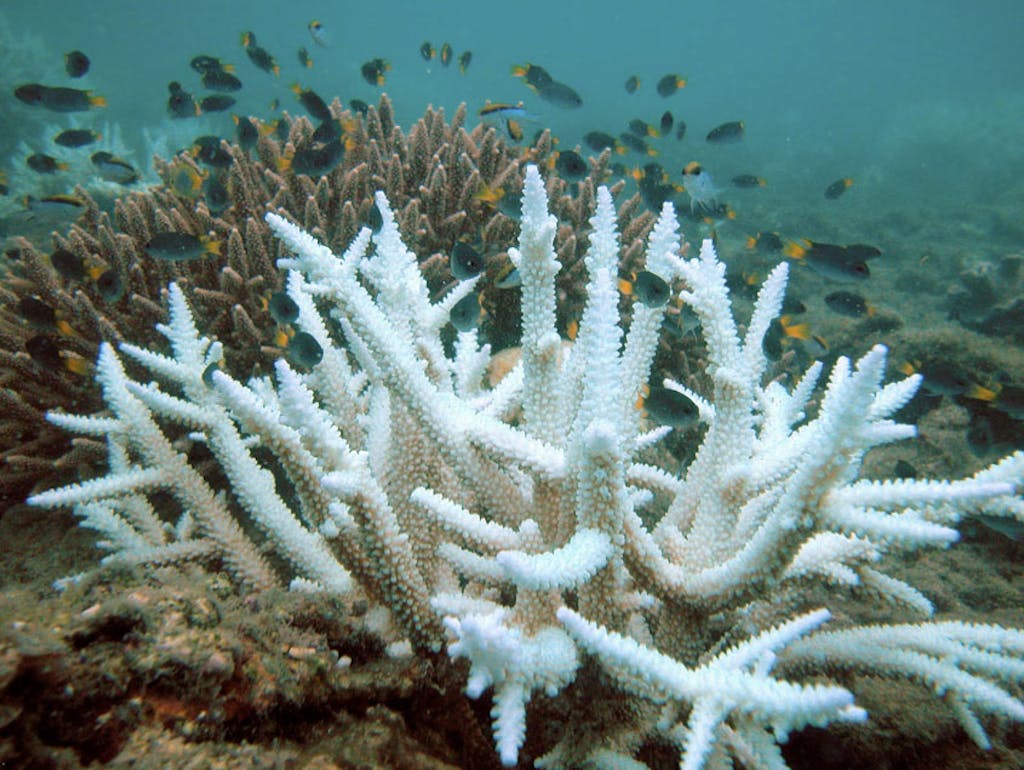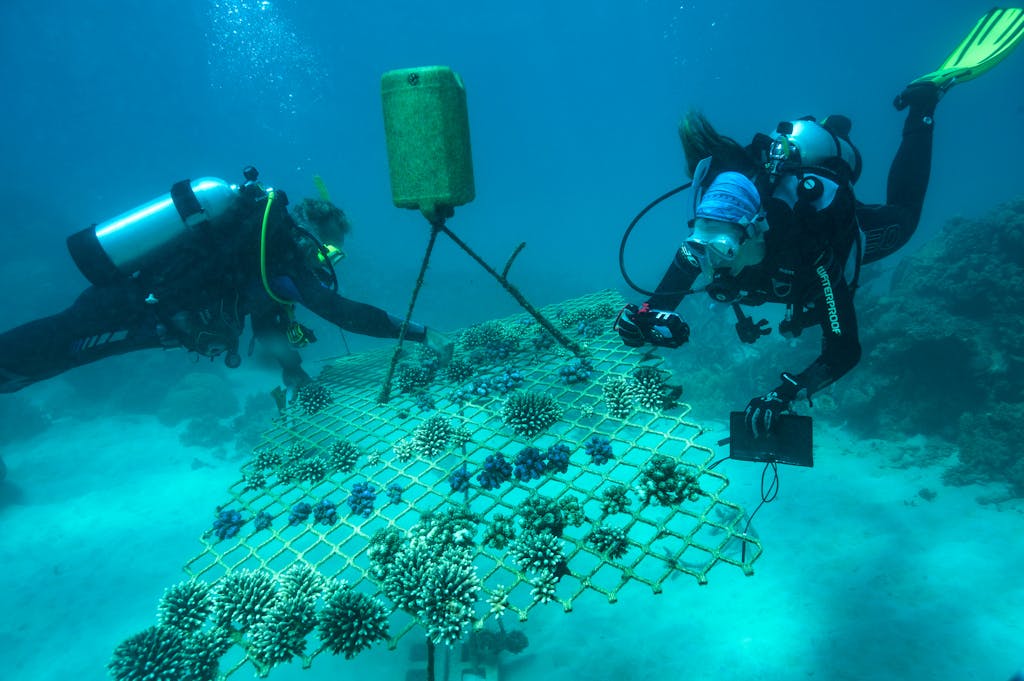Coral reefs are some of our most iconic and important ecosystems, housing a quarter of all the ocean’s marine life. But their survival is under threat.
According to the latest Intergovernmental Panel on Climate Change (IPCC) Special Report, climate change is making oceans warmer and more acidic — and these changes are having a big impact on coral reefs. Nearly all coral reefs are projected to be lost with 2°C warming by the end of the century.
Thankfully, there are scientists like Dr. Emma Camp working to stop this from happening. Dr. Camp is a coral biologist and marine bio-geochemist at the University of Technology Sydney. She is also a National Geographic Explorer and a United Nations Young Leader who studies naturally strong corals, recently termed “super corals,” and how they can make reefs more resilient. She talked about her research at the SDG Media Zone during the 2019 UN General Assembly, where climate change was a major focus for world leaders.
Originally from the U.K., Dr. Camp’s passion for research stems from a long-standing passion for the ocean, which started when she saw coral reefs for the first time on a family trip to the Carribean, “I put my mask on, then my dad helped me put my face under the water, and it was this whole world under there that you just couldn’t see from the surface. I was fascinated.”
As part of the UN Foundation’s #EyeOnClimate campaign to spotlight solutions for nature, from nature, I interviewed Dr. Camp to better understand the threats that coral reefs face from climate change, why we should all care, and how the research she’s leading can help save them.
From your perspective, what changes have you witnessed on coral reefs and what changes concern you the most?
Emma Camp: As a scientist, what I’ve actually witnessed and seen with my own eyes is that we are seeing more severe and frequent coral bleaching events. That’s really concerning for me.
What that basically means is that the coral is an animal, and it lives with micro algae that live inside the tissue, and they rely on each other; it’s a synergistic relationship. But under stress, the algae leave the coral, and that’s a problem because the coral needs them for food and they’re really important. That’s when the coral is bleached. We’re seeing more extreme weather events, particularly warming waters that are causing coral bleaching, and that’s having a really negative, rapid effect on the reefs.
If you take the Great Barrier Reef for example, 2016 and 2017 were the first years where we had back-to-back marine heat waves. It resulted in two bleaching events, which is estimated to have killed over one-third of the entire Great Barrier Reef.

That sounds alarming. For those who may not know a lot about coral reefs, why should they care about the health of these ecosystems?
EC: Coral reefs are a really important marine environment. They house many fish stocks, so lots of fish spend some time on a coral reef at some stage of their life. Although they cover only less than 0.1% of the oceans, they have 25% of the planet’s marine biodiversity, so they’re really highly productive systems. And the coral reef itself is what forms the structure for many other marine organisms to use as their home.
Coral reefs also matter particularly for low-lying countries because they’re the first sort of protection against storm damage. When waves come in, the coral reefs actually help to dissipate that energy and help to protect the shoreline from coastal erosion.
And, interestingly, a lot of unusual chemical compounds that are important in pharmaceuticals, including things like cancer treatment, actually come from coral reefs. They have a really diverse, broad value, as well as actually having real cultural significance for many locations, which you can’t put an economic price on.
Your research aims to find and grow corals that are naturally resilient to climate change. Can you walk us through how exactly you do that? Why are some corals more resilient?
EC: Coral reefs are typically found in very clear, pristine conditions. So, you can imagine your crystal blue waters where you find coral reefs, but actually there is a continuum of environments where corals can survive, and some of them are actually very hostile.
One example, an area where I’ve been studying, is in mangrove lagoons. They’re shallower, which means the water tends to be warmer, and because of the biological activity, their waters are more acidic, the oxygen is low, and there is more sediment. They’re not pristine conditions. My interest is, if we look in those environments; which corals are living there? How are they living there? And what are the costs of survival in these harsh environments?
These sorts of extreme environments are particularly interesting because, if we consider what’s happening to the ocean under climate change, we’re seeing that the waters are going to be warmer, more acidic, have low oxygen conditions.
We can use environments like mangroves as a natural laboratory to understand what are the trade-offs that corals have to make if they’re going to have a chance to survive in these extremes. Can they actually survive? And if they can, how can we use that knowledge to try to better manage some of these systems?
How do you involve the local community around the Great Barrier Reef with your research?
EC: There’s lots of stakeholders with coral reefs, whether it’s as a source of income, or protein or cultural value, or just enjoying the reef. Whoever is using the reef, they need to be involved in understanding it and protecting it. It’s a collective response.
Myself and another scientist, Associate Professor David Suggett, along with a tour operator and owner called John Edmondson, have been working together to study how bleaching events do not impact all reefs equally.
For example, I said earlier that the Great Barrier Reef had been severely impacted, but there’s two-thirds of the reef that are still in reasonable-to-good condition. That’s a really important point: not all of the reef is lost. But obviously there’s kind of a continuum, from some of the reef that’s been really severely impacted and some of it which hasn’t really been impacted. If you’ve got high value sites ecologically and economically, how can we try to maximize conservation and build resilience at those sites?
One way we are looking to do that is to use corals that have survived through either the bleaching events or were just lucky that they weren’t hit. And part of the research is trying to understand which it is. The aim is to build resilience by increasing the number of corals at those sites.
We’re working with tour operators to use their site knowledge and infrastructure to set up coral nurseries on the Great Barrier Reef, so that the tour operators can plant corals, build resilience, and give the site the best chance it has to survive stress into the future. This specific set-up that we have on the Great Barrier Reef is called the “Coral Nurture Program.” While coral gardening or restoration has been around for many years, this particular program is sort of a unique platform that is between scientists and tour operators that focuses on site stewardship.
Our longer term plan, as we understand more about extreme coral and the tolerance that they have, is to transfer some of that knowledge into the Coral Nurture Program, so that we can better future-proof certain areas.

Why should protecting and restoring ecosystems — like the work that you’re doing through the Coral Nurture Program — be considered a climate solution?
EC: Nature’s got many mechanisms to remove carbon dioxide and other contributors to climate change that are way more efficient than any technological solutions. Trees, for example, are a great example of this, and you’ve got seagrass in the ocean environment.
Preserving and restoring environments that have key biological processes that help to regulate climate is just a logical and really efficient way to help tackle climate change. But of course, we need to consider the restoration of ecosystems alongside climate action across other sectors like energy and transportation.
What’s your favorite part of your job?
EC: I think there’s two parts. One is to actually be able to do something that you feel is going to have a positive impact on society. For me, the big driver is that I want to ensure in the future that, if I have kids, they and their generation have a coral reef that they can visit. I feel lucky that I’m doing something that I feel can provide knowledge, and hopefully some mechanisms, to ensure that.
The second part that I really love about my job is that it’s really diverse. Just the fact that I’m privileged enough to spend time on the reef, or I spend time in the lab, and I’m not always just in the office. And I get to meet amazing people and work with amazing people. That, I feel, is a real privilege and a great part of my job.
TAKE ACTION
To learn more about the #EyeOnClimate campaign and share the solutions you see, visit eyeonclimate.org.



 View All Blog Posts
View All Blog Posts

